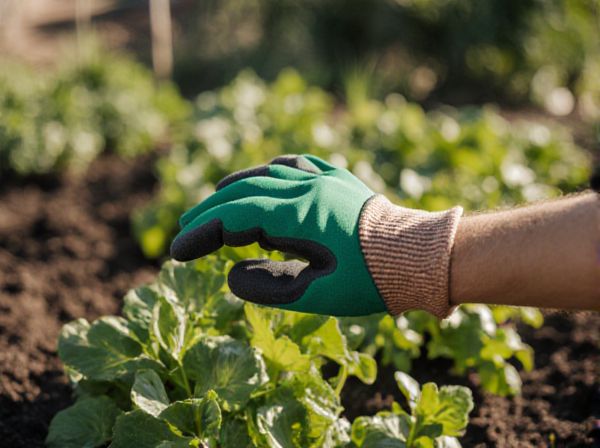
No-till Farming vs Conventional Tillage Illustration
No-till farming preserves soil structure and enhances microbial activity by minimizing soil disturbance, which improves water retention and reduces erosion compared to conventional tillage. Conventional tillage disrupts soil ecosystems and accelerates organic matter decomposition, leading to decreased fertility and increased carbon emissions. Embracing no-till practices supports sustainable permaculture by promoting healthier soils and long-term productivity.
Table of Comparison
| Aspect | No-till Farming | Conventional Tillage |
|---|---|---|
| Soil Disturbance | Minimal disturbance, preserves soil structure | Frequent plowing, disrupts soil layers |
| Soil Erosion | Significantly reduces erosion | Increases erosion risk |
| Organic Matter Retention | Maintains higher organic content | Reduces organic matter over time |
| Soil Moisture | Improves moisture retention | Often causes moisture loss |
| Weed Control | Relies on cover crops, herbicides | Physical weed removal by plowing |
| Energy Use | Lower fuel consumption | Higher fuel usage due to tillage |
| Crop Yield | Comparable or improved yields long-term | Consistent yields, possible short-term advantage |
| Environmental Impact | Enhances biodiversity, reduces pollution | Negatively impacts soil and biodiversity |
Understanding No-Till Farming in Permaculture
No-till farming in permaculture emphasizes minimal soil disturbance, preserving soil structure, moisture, and microbial life to enhance long-term fertility. This method contrasts with conventional tillage, which disrupts soil ecosystems, increases erosion, and depletes organic matter. By maintaining natural ground cover and promoting biodiversity, no-till techniques support sustainable crop production and carbon sequestration in agroecosystems.
Conventional Tillage: Methods and Impacts
Conventional tillage involves the mechanical agitation of soil through plowing, harrowing, and cultivating to prepare seedbeds and control weeds, often disrupting soil structure and organic matter. This practice accelerates soil erosion, reduces microbial diversity, and depletes essential nutrients, negatively impacting soil fertility and carbon sequestration. Frequent disturbance in conventional tillage systems leads to compaction issues and diminished water retention, undermining long-term soil health and agricultural sustainability.
Soil Health Comparison: No-Till vs. Tillage
No-till farming preserves soil structure, enhances microbial diversity, and increases organic matter, leading to improved soil health compared to conventional tillage. Conventional tillage disrupts soil aggregates, reduces microbial activity, and accelerates organic matter loss, resulting in erosion and nutrient depletion. Studies show no-till systems promote higher water retention, better nutrient cycling, and greater biological activity essential for sustainable permaculture.
Water Retention and Erosion Control
No-till farming significantly enhances water retention by maintaining soil structure and organic matter, reducing evaporation and runoff compared to conventional tillage. Conventional tillage disrupts soil aggregates, leading to increased erosion and loss of topsoil, whereas no-till practices preserve ground cover, minimizing soil erosion and promoting infiltration. Research shows no-till fields retain up to 30% more moisture, supporting sustainable crop growth and resilience against drought conditions.
Weed Management Techniques in Both Systems
No-till farming uses cover crops, mulching, and targeted herbicide applications to suppress weeds while preserving soil structure and microbial health. Conventional tillage relies on mechanical disturbance to uproot weeds but often leads to soil erosion and disrupts beneficial organisms. Integrating crop rotation and organic mulches in both systems enhances weed control and promotes sustainable permaculture practices.
Effects on Soil Microbial Life
No-till farming preserves soil structure, promoting diverse and abundant microbial communities essential for nutrient cycling and organic matter decomposition. Conventional tillage disrupts soil habitats, reducing microbial biomass and enzymatic activity, which impairs soil fertility and carbon sequestration. Enhanced microbial diversity under no-till practices supports resilient, sustainable permaculture systems by maintaining soil health and reducing dependency on chemical inputs.
Crop Yields: No-Till Farming vs Conventional Tillage
No-till farming enhances soil structure and moisture retention, often resulting in comparable or higher crop yields compared to conventional tillage. Studies indicate that no-till systems can increase yields by up to 10% in drought-prone areas due to improved water conservation. Conventional tillage may boost short-term yields by promoting soil aeration but frequently leads to long-term declines in soil fertility and productivity.
Carbon Sequestration and Climate Impact
No-till farming significantly enhances carbon sequestration by preserving soil organic matter and minimizing soil disturbance, which reduces carbon dioxide emissions compared to conventional tillage. Conventional tillage aerates the soil, accelerating microbial decomposition and releasing stored carbon into the atmosphere, contributing to climate change. Adopting no-till practices supports soil health and mitigates greenhouse gas emissions, making it a sustainable strategy in permaculture for climate impact reduction.
Long-term Sustainability: Which Method Wins?
No-till farming enhances long-term sustainability by preserving soil structure, increasing organic matter, and minimizing erosion compared to conventional tillage, which disrupts soil ecosystems and accelerates degradation. Studies show that no-till practices improve water retention and carbon sequestration, essential for combating climate change and maintaining fertile land over time. Conversely, conventional tillage's high energy input and soil disturbance often lead to diminished productivity and increased reliance on chemical inputs, questioning its sustainability in permaculture systems.
Adopting No-Till Practices in Permaculture Gardens
No-till farming enhances soil structure by preserving organic matter and promoting beneficial microbial activity, which aligns with permaculture principles of sustainable land use. Permaculture gardens adopting no-till practices experience improved water retention and reduced erosion, leading to healthier plant growth and increased biodiversity. This method reduces labor and fuel costs associated with conventional tillage, fostering a more efficient and ecologically balanced garden system.
No-till Farming vs Conventional Tillage Infographic

 gardendif.com
gardendif.com